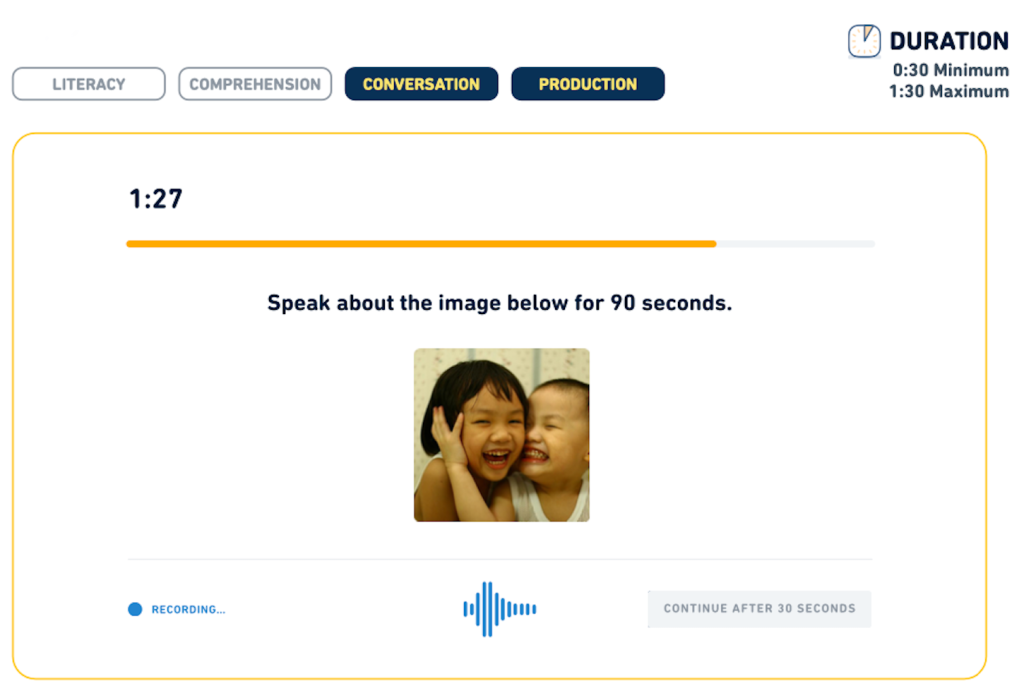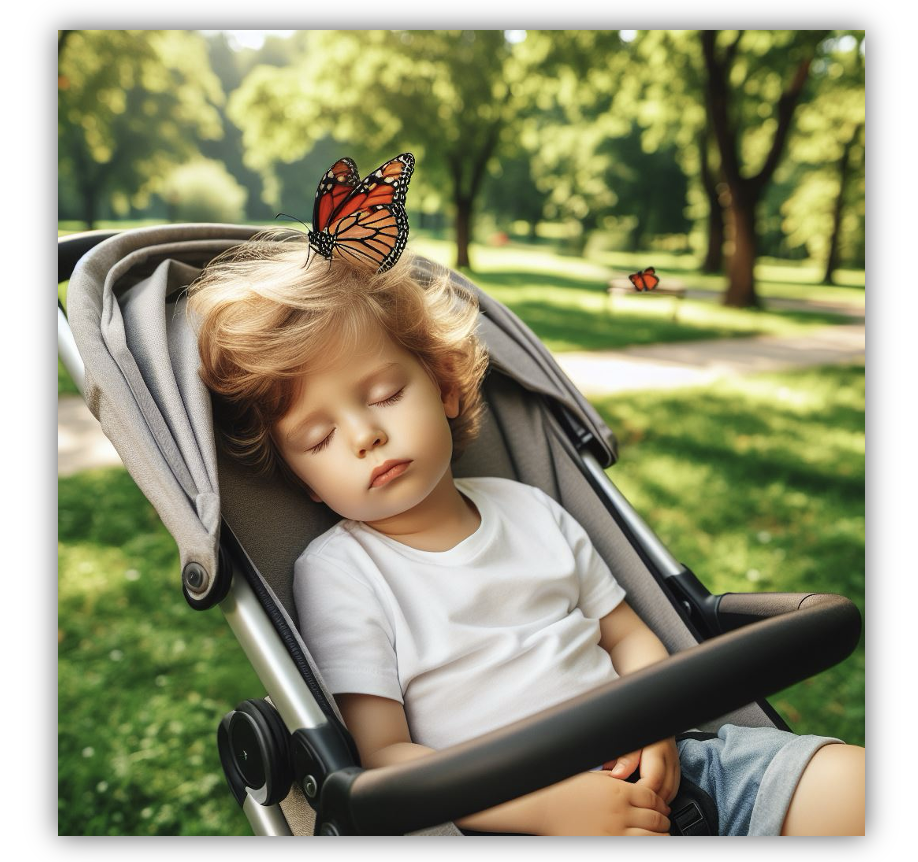Tecniche migliori per il test di inglese Duolingo: padroneggiare il compito 'Parla della foto'
Ciao, futuri campioni del DET (Duolingo English Test)! Benvenuti su DET Practice. Oggi esploreremo come affrontare la sezione ‘Speak about the Photo’ nel DET. Innanzitutto, diamo un'occhiata a cosa sia la domanda ‘Speak about the Photo’:

Questa sezione, presente nella guida ufficiale allo studio del DET, prevede un unico esercizio orale. A differenza dei compiti di speaking nel TOEFL o IELTS, questo compito richiede di descrivere verbalmente una fotografia in inglese. Incide sia sui punteggi di ‘Conversazione’ che di ‘Produzione’, con un tempo di risposta di 30-90 secondi.
* Per una introduzione più dettagliata al compito ‘Speak about the Photo’, raccomandiamo il nostro precedente articolo: “Speak about the Photo“.
Per comprendere i punteggi del DET e le strategie per migliorare, consulta “Duolingo English Test Scores: Insights and Comparisons” e “The Ultimate Guide to the Duolingo English Test” rispettivamente.
Ottenere un buon punteggio nei compiti orali richiede di mantenere la fluidità entro il tempo assegnato. Questo è cruciale anche in altri test di lingua come TOEFL o IELTS. Una sfida in ‘Speak about the Photo’ è la mancanza di prompt predefiniti, il che può rendere difficile sostenere una risposta di 1 minuto e 30 secondi, soprattutto quando gli elementi della foto sono limitati. Quali strategie possiamo quindi impiegare?
Strategia per ‘Speak about the Photo’
Prima di approfondire le tecniche specifiche, consideriamo una foto di esempio. Si noti che il DET utilizza spesso immagini con persone, che possono includere primi piani di espressioni o azioni.

Descrizione Obiettiva
Nel DET, i compiti orali vengono valutati in base alla rilevanza rispetto all'argomento. Raccomandiamo di iniziare con una descrizione obiettiva della foto nei primi 30 secondi per garantire che la risposta sia pertinente. Ad esempio, se la foto mostra un bambino biondo che dorme in un passeggino in un ambiente all'aperto con una rigogliosa vegetazione, forse una foresta o un parco, potresti descrivere l'abbigliamento del bambino (una maglietta bianca e pantaloncini grigi che suggeriscono un caldo pomeriggio estivo) e una farfalla posata sulla loro testa. Potresti anche trasmettere l'atmosfera di pace e ipotizzare che un genitore abbia catturato questo momento sereno. In ‘Speak about the Photo’, considera di discutere persone, abbigliamento, azioni, professioni, identità, stati emotivi, espressioni facciali e ambienti circostanti.
Secondo la nostra discussione precedente, la tua risposta potrebbe essere simile a questa:
So, what we’re looking at here is really a picture-perfect scene taken outdoors. The greenery is vibrant—there’s grass, and trees all around, so I’m thinking this could be a beautiful park or maybe even a bit of forest area. Now, right in the heart of this natural setting, we’ve got this adorable blond child, just fast asleep in their stroller. They’re dressed in the simplest summer outfit, you know, a white T-shirt, grey shorts—totally what you’d wear on a sunny afternoon. And there’s this little surprise—a butterfly has landed right on their head! It’s one of those moments that’s just so peaceful, so serene, it’s got to be one of those memories that parents love to capture. It’s the kind of day that just feels like a gift, doesn’t it?
Sì, questa risposta suona bene. Ma c'è un problema, è troppo breve. Questa risposta potrebbe non essere sufficiente per mantenere 1 minuto e 30 secondi di tempo di discorso.
Commento Personale
È accettabile aggiungere commenti personali? Sì. Dopo aver descritto oggettivamente la foto, i commenti personali relativi al contenuto sono una strategia valida. Ma presta attenzione al numero di frasi (3-5 frasi) per evitare di andare fuori tema. Il commento personale aiuta ad espandere la risposta rimanendo pertinente.
Per l'esempio sopra, potremmo aggiungere:
Well, looking at this image really warms my heart. It’s such a delightful scene. Being outdoors, taking in the fresh air, it’s incredibly beneficial for kids—both for their physical health and mental well-being. They get to be up close to nature, run around, jump, and even interact with wildlife, like this gentle butterfly here. It’s fantastic because it’s not just about staying active; it’s about feeding their curiosity as well. I truly believe that kids should engage in outdoor activities more often.
La risposta sembra buona, abbiamo aggiunto i nostri commenti e cercato di mantenere la risposta sul tema. Quindi, ricordate, aggiungere commenti personali è un buon modo per ampliare la risposta alla domanda ‘Speak about the Photo’. Ci sono altri modi per espandere la risposta? Continuate a leggere per scoprirlo.
Contesto della Foto
Considera il contesto della foto. Possiamo riflettere sulle circostanze in cui è stata scattata una foto. Come nel nostro esempio sopra, possiamo immaginare. Questa foto potrebbe essere stata scattata dai genitori del bambino, potrebbe essere un fine settimana (perché non devono lavorare, hanno tempo per andare all'aperto o fare una passeggiata nel parco o rilassarsi), una scena di un'uscita in famiglia. Oppure, cosa ti ricorda questa foto? Ad esempio, la tua esperienza d'infanzia. Forse possiamo dire che questa foto mi ricorda la mia infanzia, i miei genitori e io andavamo spesso al parco vicino a casa nostra, e il paesaggio nel parco era bello come la foto. Bene, è ora di espandere ulteriormente la risposta, continuiamo con la risposta precedente:
You know, this photo might very well have been taken by the child’s parents, capturing a slice of family time—perhaps over the weekend when there’s no work to rush to, allowing for a leisurely stroll in the outdoors or some relaxing time in the park. And it’s the kind of scene that nudges at my own memories, taking me back to my childhood. My parents would often take me to the park near our home, much like the one in this picture, where the scenery was just as picturesque.
Ora la risposta sembra più sostanziale.
Aggiungi Sentimenti Personali
Sarà fuori tema? Non se la tua operazione è corretta. Questa è la parte in cui mostri davvero le tue capacità, perché stiamo parlando dei sentimenti che la foto ci porta, ad esempio, possiamo dire questo:
So, it’s more than just a photograph; it’s a reminder of those carefree, joyful days. It’s about the bond we share with our loved ones and the simple pleasures of life, like watching your child sleep peacefully under the watchful eye of nature.```html You know, this image is a beautiful echo of times spent with family, treasured and timeless.
Bene, questo è tutto. Credo che abbiamo un esempio di risposta orale abbastanza completo e di alto livello, mettiamo tutto insieme:
So, what we’re looking at here is really a picture-perfect scene taken outdoors. The greenery is vibrant—there’s grass, and trees all around, so I’m thinking this could be a beautiful park or maybe even a bit of forest area. Now, right in the heart of this natural setting, we’ve got this adorable blond child, just fast asleep in their stroller. They’re dressed in the simplest summer outfit, you know, a white T-shirt, grey shorts—totally what you’d wear on a sunny afternoon. And there’s this little surprise—a butterfly has landed right on their head! It’s one of those moments that’s just so peaceful, so serene, it’s got to be one of those memories that parents love to capture. It’s the kind of day that just feels like a gift, doesn’t it?
Well, looking at this image really warms my heart. It’s such a delightful scene. Being outdoors, taking in the fresh air, it’s incredibly beneficial for kids—both for their physical health and mental well-being. They get to be up close to nature, run around, jump, and even interact with wildlife, like this gentle butterfly here. It’s fantastic because it’s not just about staying active; it’s about feeding their curiosity as well. I truly believe that kids should engage in outdoor activities more often.
You know, this photo might very well have been taken by the child’s parents, capturing a slice of family time—perhaps over the weekend when there’s no work to rush to, allowing for a leisurely stroll in the outdoors or some relaxing time in the park. And it’s the kind of scene that nudges at my own memories, taking me back to my childhood. My parents would often take me to the park near our home, much like the one in this picture, where the scenery was just as picturesque.
So, it’s more than just a photograph; it’s a reminder of those carefree, joyful days. It’s about the bond we share with our loved ones and the simple pleasures of life, like watching your child sleep peacefully under the watchful eye of nature. You know, this image is a beautiful echo of times spent with family, treasured and timeless.
Combinando questi approcci, puoi creare una risposta orale completa e ben sviluppata. Speriamo che queste strategie ti aiutino a eccellere nella sezione ‘Speak about the Photo’ del DET. Buona fortuna con il tuo Duolingo English Test!
Inizia a praticare oggi iscrivendoti al nostro banco domande DET gratuitamente.






